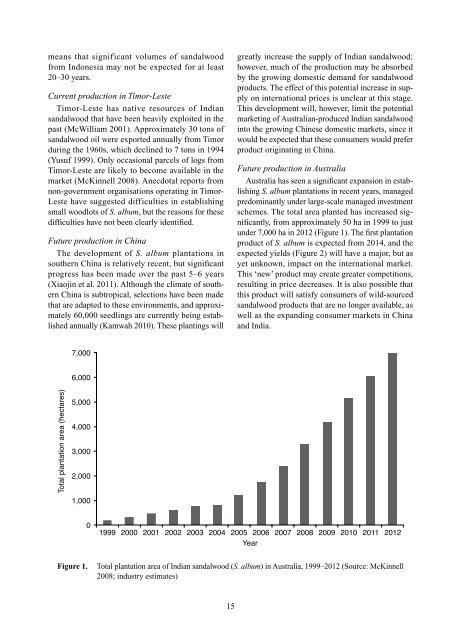Opportunities for the smallholder sandalwood industry in ... - ACIAR
Opportunities for the smallholder sandalwood industry in ... - ACIAR
Opportunities for the smallholder sandalwood industry in ... - ACIAR
You also want an ePaper? Increase the reach of your titles
YUMPU automatically turns print PDFs into web optimized ePapers that Google loves.
means that significant volumes of <strong>sandalwood</strong><br />
from Indonesia may not be expected <strong>for</strong> at least<br />
20–30 years.<br />
Current production <strong>in</strong> Timor-Leste<br />
Timor-Leste has native resources of Indian<br />
<strong>sandalwood</strong> that have been heavily exploited <strong>in</strong> <strong>the</strong><br />
past (McWilliam 2001). Approximately 30 tons of<br />
<strong>sandalwood</strong> oil were exported annually from Timor<br />
dur<strong>in</strong>g <strong>the</strong> 1960s, which decl<strong>in</strong>ed to 7 tons <strong>in</strong> 1994<br />
(Yusuf 1999). Only occasional parcels of logs from<br />
Timor-Leste are likely to become available <strong>in</strong> <strong>the</strong><br />
market (McK<strong>in</strong>nell 2008). Anecdotal reports from<br />
non-government organisations operat<strong>in</strong>g <strong>in</strong> Timor-<br />
Leste have suggested difficulties <strong>in</strong> establish<strong>in</strong>g<br />
small woodlots of S. album, but <strong>the</strong> reasons <strong>for</strong> <strong>the</strong>se<br />
difficulties have not been clearly identified.<br />
Future production <strong>in</strong> Ch<strong>in</strong>a<br />
The development of S. album plantations <strong>in</strong><br />
sou<strong>the</strong>rn Ch<strong>in</strong>a is relatively recent, but significant<br />
progress has been made over <strong>the</strong> past 5–6 years<br />
(Xiaoj<strong>in</strong> et al. 2011). Although <strong>the</strong> climate of sou<strong>the</strong>rn<br />
Ch<strong>in</strong>a is subtropical, selections have been made<br />
that are adapted to <strong>the</strong>se environments, and approximately<br />
60,000 seedl<strong>in</strong>gs are currently be<strong>in</strong>g established<br />
annually (Kamwah 2010). These plant<strong>in</strong>gs will<br />
greatly <strong>in</strong>crease <strong>the</strong> supply of Indian <strong>sandalwood</strong>;<br />
however, much of <strong>the</strong> production may be absorbed<br />
by <strong>the</strong> grow<strong>in</strong>g domestic demand <strong>for</strong> <strong>sandalwood</strong><br />
products. The effect of this potential <strong>in</strong>crease <strong>in</strong> supply<br />
on <strong>in</strong>ternational prices is unclear at this stage.<br />
This development will, however, limit <strong>the</strong> potential<br />
market<strong>in</strong>g of Australian-produced Indian <strong>sandalwood</strong><br />
<strong>in</strong>to <strong>the</strong> grow<strong>in</strong>g Ch<strong>in</strong>ese domestic markets, s<strong>in</strong>ce it<br />
would be expected that <strong>the</strong>se consumers would prefer<br />
product orig<strong>in</strong>at<strong>in</strong>g <strong>in</strong> Ch<strong>in</strong>a.<br />
Future production <strong>in</strong> Australia<br />
Australia has seen a significant expansion <strong>in</strong> establish<strong>in</strong>g<br />
S. album plantations <strong>in</strong> recent years, managed<br />
predom<strong>in</strong>antly under large-scale managed <strong>in</strong>vestment<br />
schemes. The total area planted has <strong>in</strong>creased significantly,<br />
from approximately 50 ha <strong>in</strong> 1999 to just<br />
under 7,000 ha <strong>in</strong> 2012 (Figure 1). The first plantation<br />
product of S. album is expected from 2014, and <strong>the</strong><br />
expected yields (Figure 2) will have a major, but as<br />
yet unknown, impact on <strong>the</strong> <strong>in</strong>ternational market.<br />
This ‘new’ product may create greater competitions,<br />
result<strong>in</strong>g <strong>in</strong> price decreases. It is also possible that<br />
this product will satisfy consumers of wild-sourced<br />
<strong>sandalwood</strong> products that are no longer available, as<br />
well as <strong>the</strong> expand<strong>in</strong>g consumer markets <strong>in</strong> Ch<strong>in</strong>a<br />
and India.<br />
7,000<br />
6,000<br />
Total plantation area (hectares)<br />
5,000<br />
4,000<br />
3,000<br />
2,000<br />
1,000<br />
0<br />
1999 2000 2001 2002 2003 2004 2005 2006 2007 2008 2009 2010 2011 2012<br />
Year<br />
Figure 1.<br />
Total plantation area of Indian <strong>sandalwood</strong> (S. album) <strong>in</strong> Australia, 1999–2012 (Source: McK<strong>in</strong>nell<br />
2008; <strong><strong>in</strong>dustry</strong> estimates)<br />
15
















